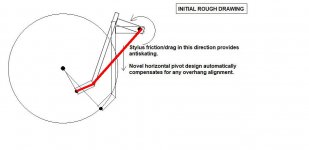Something for others to Chew On.....
It would seem to me that a design like this was never investigated, but would seem to correct and even eliminate the known pivoted tonearm issues
Thoughts?

It would seem to me that a design like this was never investigated, but would seem to correct and even eliminate the known pivoted tonearm issues
Thoughts?
Imagine the entire arm is inside a shoebox and you only know where the pivot and cartridge/stylus are. The arm could be a snake or it could be the box itself, but the forces are exactly the same.
Hi wiseoldtech,Something for others to Chew On.....
It would seem to me that a design like this was never investigated, but would seem to correct and even eliminate the known pivoted tonearm issues
Thoughts?
View attachment 1048221
As you seem to be a knowledgeable individual, it doesn't make sense that you would post something like that.
Sincerely,
Ralf
Do explain why.This offers no geometric advantage over a “conventional” tone arm.
I'm sure it would be interesting.
Nonetheless, my main turntable is a linear tracker, so no worries of antiskating and alignment.
Well, I'm curious about the forces involved when playing a record - the centrifical generated "pull" on the arm from stylus drag, and the above geometry which would seem to cancel that effect.Hi wiseoldtech,
As you seem to be a knowledgeable individual, it doesn't make sense that you would post something like that.
Sincerely,
Ralf
The more the "pull", the more the arm would "tend" to drift outward, instead of inward.
And the horizontal pivot, causing the arm to move "rearward" as it moves along the record, maintaining good alignment of the stylus.
The shape of your arm does not affect the force vectors involved, namely drag tangential to the groove and constraint, from the stylus point back to the arm pivot.
Please, give me some more info, details, thanks.The shape of your arm does not affect the force vectors involved, namely drag tangential to the groove and constraint, from the stylus point back to the arm pivot.
Seriously?
This is as much as i can be bothered with. There is a simple force vector diagram on page 3.
https://www.audioasylum.com/images/Skating-force-Misunderstanding-and-misinformation-about-it.pdf
This is as much as i can be bothered with. There is a simple force vector diagram on page 3.
https://www.audioasylum.com/images/Skating-force-Misunderstanding-and-misinformation-about-it.pdf
Interesting design. Its good to have different ideas. I guess if the headshell is straight, the design (because Stlus drag) would somewhat compensate for inward force. If we apply string test one can imagine it. How much advantageous or counterproductive ? only building and changing dimensions of various segments can tell.
I think first mention of separate vertical and horizontal pivots (and different design) was from Mr. David Read (Wireless world November 1980). However the tonearm segments position was on opposite side and goal was different.
regards
I think first mention of separate vertical and horizontal pivots (and different design) was from Mr. David Read (Wireless world November 1980). However the tonearm segments position was on opposite side and goal was different.
regards
The 'novel design' is just a traditional tonearm (drawn in red)Well, I'm curious about the forces involved when playing a record - the centrifical generated "pull" on the arm from stylus drag, and the above geometry which would seem to cancel that effect.
The more the "pull", the more the arm would "tend" to drift outward, instead of inward.
And the horizontal pivot, causing the arm to move "rearward" as it moves along the record, maintaining good alignment of the stylus.
Attachments
Draw a line through the length of the cartridge cantilever and past the tone arm pivot. That’s the direction of the force vector from stylus drag.Do explain why.
I'm sure it would be interesting.
Nonetheless, my main turntable is a linear tracker, so no worries of antiskating and alignment.
Now, draw another line perpendicular to that one and through the tone arm pivot. The length of that line is the torque arm.
That’s your force vector diagram. It does not change based on the shape of the tone arm. Only the pivot to stylus distance and the cartridge offset angle matter.
I think the forces may be different (Not sure) as two pivots are separate. The green dot one is verticle pivot and red one is horizontal pivot.
.

.
Don't know if it's helpful, but I wrote this some time ago- http://www.conradhoffman.com/AntiSkate.htm
It's traditional in the sense that it has an offset headshell.The 'novel design' is just a traditional tonearm (drawn in red)
However, you're not seeing the fact that since the actual connection of the arm tube is to the left of the horizontal pivot point.
A "pull" at the stylus end would create a force that would tend to make the horizontal pivot turn anti-clockwise.
Yes, the rough drawing doesn't show the vertical (green) pivot, thanks.I think the forces may be different (Not sure) as two pivots are separate. The green dot one is verticle pivot and red one is horizontal pivot.
. View attachment 1048307
Sorry.The 'novel design' is just a traditional tonearm (drawn in red)
Include the vertical pivot that is not shown.
This is only a rough sketch.
The location of the vertical pivot does not change the force vector diagram.
You're looking at the design through blinders.The location of the vertical pivot does not change the force vector diagram.
- Home
- Source & Line
- Analogue Source
- An ODD tonearm design.
